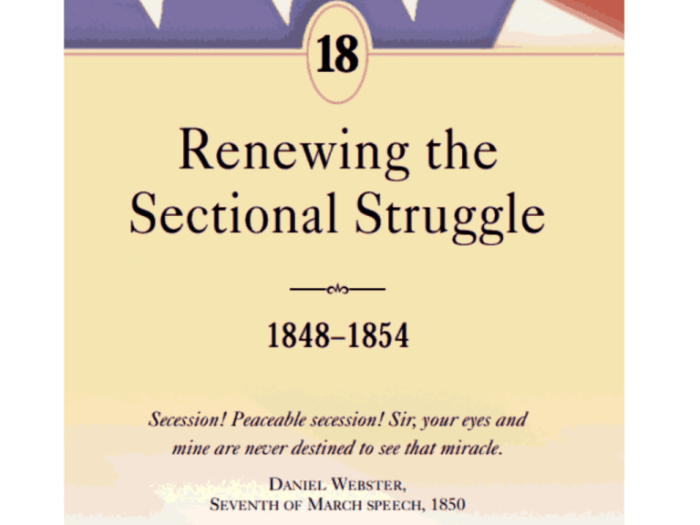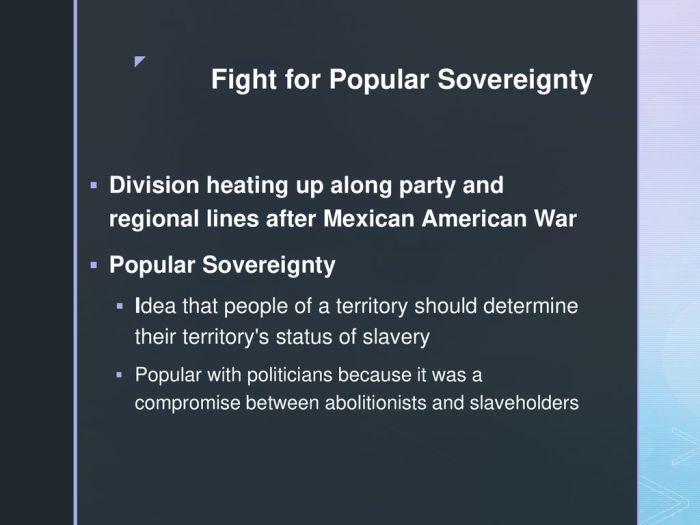Chapter 18 renewing the sectional struggle – Chapter 18: Renewing the Sectional Struggle delves into the complexities of the antebellum period, marked by escalating tensions between the North and South. This chapter explores the factors that reignited sectional conflict, leading to the eventual outbreak of the American Civil War.
The Missouri Compromise and Compromise of 1850 temporarily quelled sectional tensions, but the Kansas-Nebraska Act of 1854 reopened the debate over slavery’s expansion, exacerbating the divide. The Supreme Court’s Dred Scott v. Sandford decision further inflamed tensions, solidifying the divide between the North and South.
Causes of the Renewed Sectional Struggle
The sectional tensions that had been simmering since the founding of the United States reignited in the mid-19th century, leading to the American Civil War. Several key factors contributed to this renewed conflict.
The Missouri Compromise and the Compromise of 1850
The Missouri Compromise of 1820 admitted Missouri as a slave state and Maine as a free state, maintaining a balance in the Senate. However, the Compromise of 1850, which included the Fugitive Slave Act, further inflamed tensions by extending slavery into new territories acquired from Mexico.
The Kansas-Nebraska Act
The Kansas-Nebraska Act of 1854 repealed the Missouri Compromise, allowing the territories of Kansas and Nebraska to decide their own slavery status through popular sovereignty. This led to a violent conflict known as “Bleeding Kansas” and heightened sectional divisions.
The Dred Scott v. Sandford Supreme Court Decision
In 1857, the Supreme Court ruled in Dred Scott v. Sandford that slaves were not citizens and could not sue in federal court. This decision further eroded support for slavery in the North and deepened the divide between the two regions.
Manifest Destiny and Expansionism

The concept of Manifest Destiny, the belief that the United States was destined to expand westward across the North American continent, contributed to sectional tensions.
Acquisition of New Territories
The Louisiana Purchase (1803) and the Mexican Cession (1848) significantly expanded the United States, raising questions about the expansion of slavery into these new territories.
Debate over Slavery Expansion, Chapter 18 renewing the sectional struggle
The debate over whether slavery should be allowed in new territories intensified sectional divisions. Pro-slavery advocates argued for the expansion of slavery, while abolitionists condemned it.
The Role of Abolitionists and Pro-Slavery Advocates: Chapter 18 Renewing The Sectional Struggle

Abolitionists and pro-slavery advocates played a significant role in shaping public opinion and fueling sectional conflict.
Abolitionist Movement
Abolitionists, such as William Lloyd Garrison and Frederick Douglass, sought to end slavery through peaceful means. They used literature, speeches, and other forms of activism to promote their cause.
Pro-Slavery Advocacy
Pro-slavery advocates, such as John C. Calhoun and Jefferson Davis, defended slavery as a positive institution and argued for its expansion into new territories.
Economic and Social Differences between the North and South

Significant economic and social differences between the North and South contributed to sectional tensions.
Economic Systems
The North had a diversified economy based on industry, commerce, and agriculture, while the South relied heavily on slave-based agriculture, particularly cotton production.
Social Structures
Slavery shaped the social structure of the South, creating a rigid hierarchy with a small elite of slave owners and a large population of enslaved people. In contrast, the North had a more egalitarian society.
Top FAQs
What was the significance of the Missouri Compromise?
The Missouri Compromise temporarily resolved the issue of slavery’s expansion into new territories, admitting Missouri as a slave state and Maine as a free state while prohibiting slavery north of the 36°30′ parallel.
How did the Kansas-Nebraska Act contribute to sectional tensions?
The Kansas-Nebraska Act repealed the Missouri Compromise, allowing for the expansion of slavery into territories north of the 36°30′ parallel, further escalating tensions between the North and South.
What was the impact of the Dred Scott v. Sandford decision?
The Dred Scott v. Sandford decision ruled that African Americans were not citizens and could not sue in federal court, further inflaming tensions between the North and South and contributing to the outbreak of the Civil War.